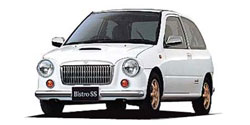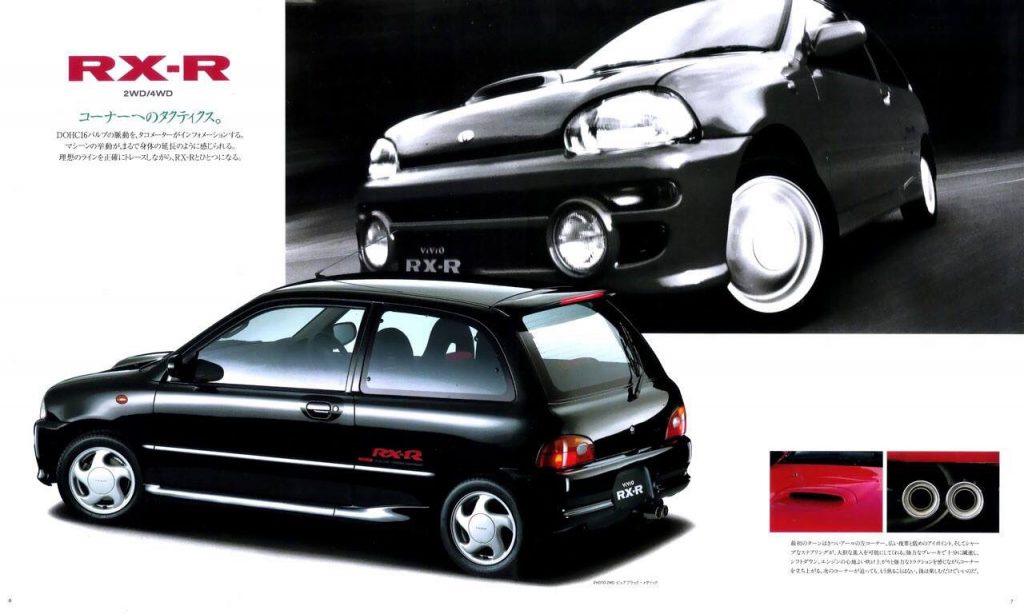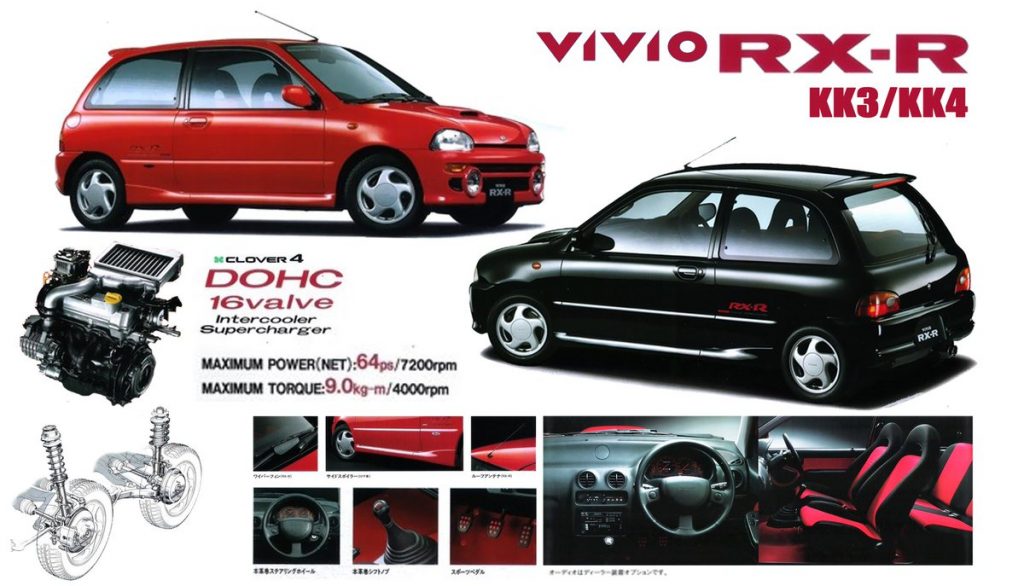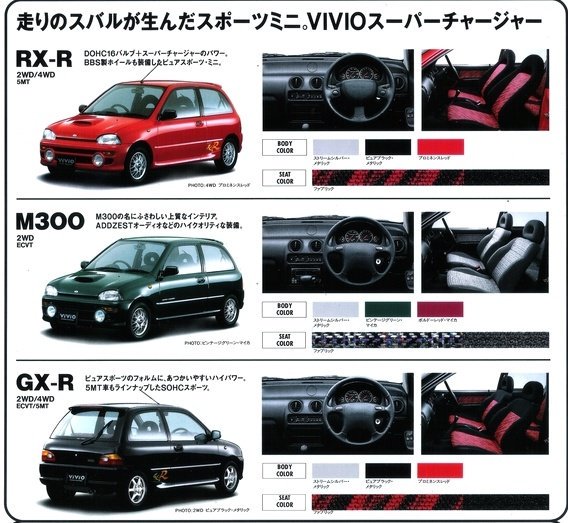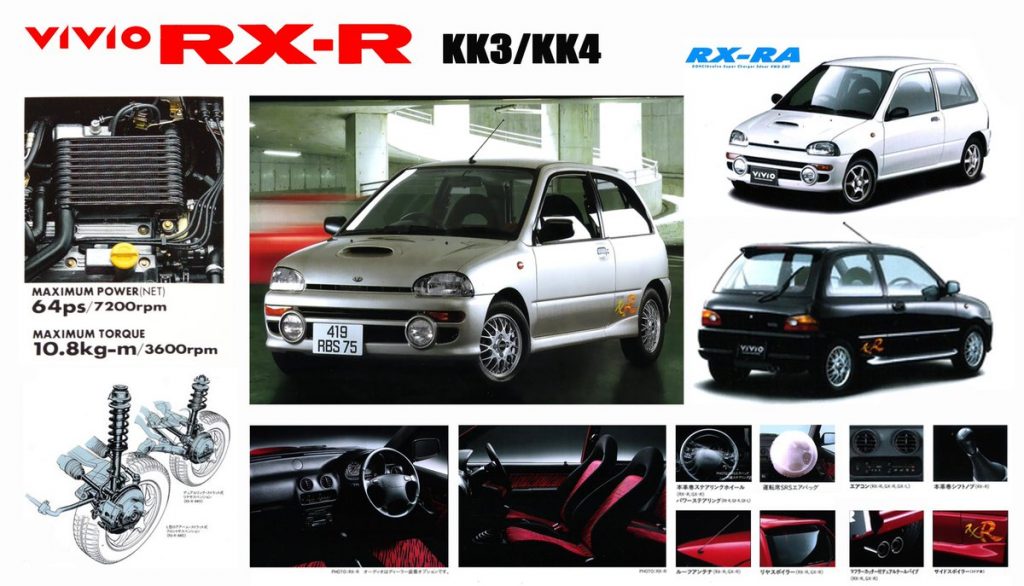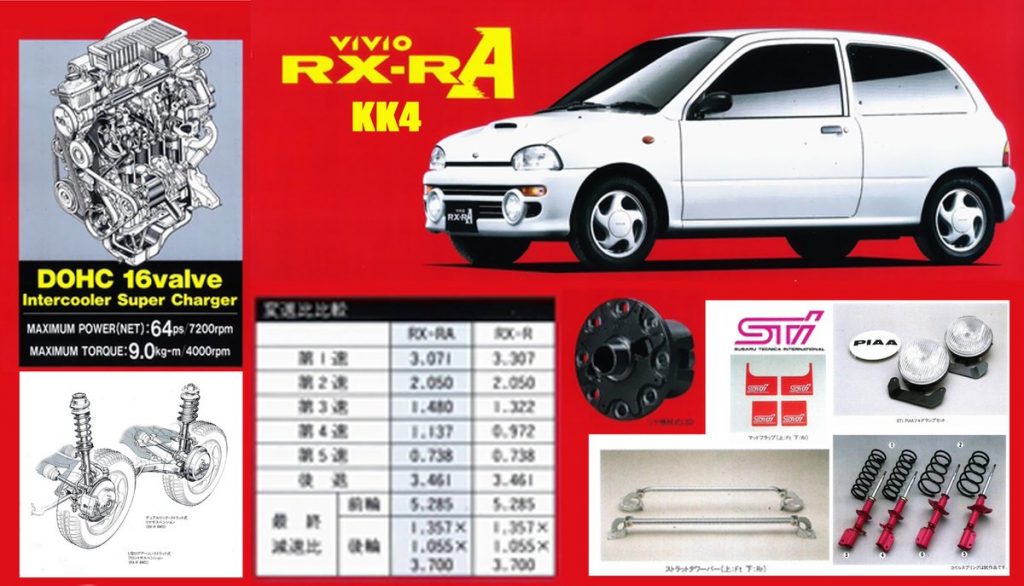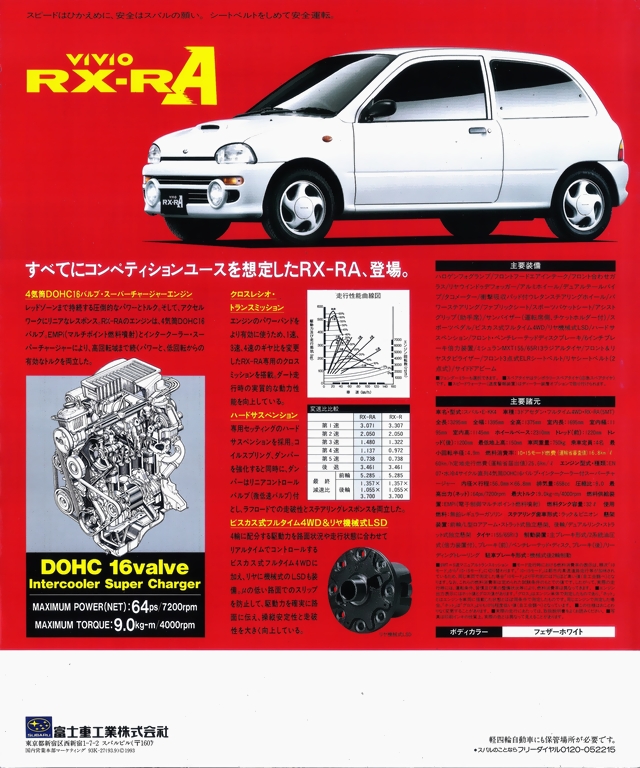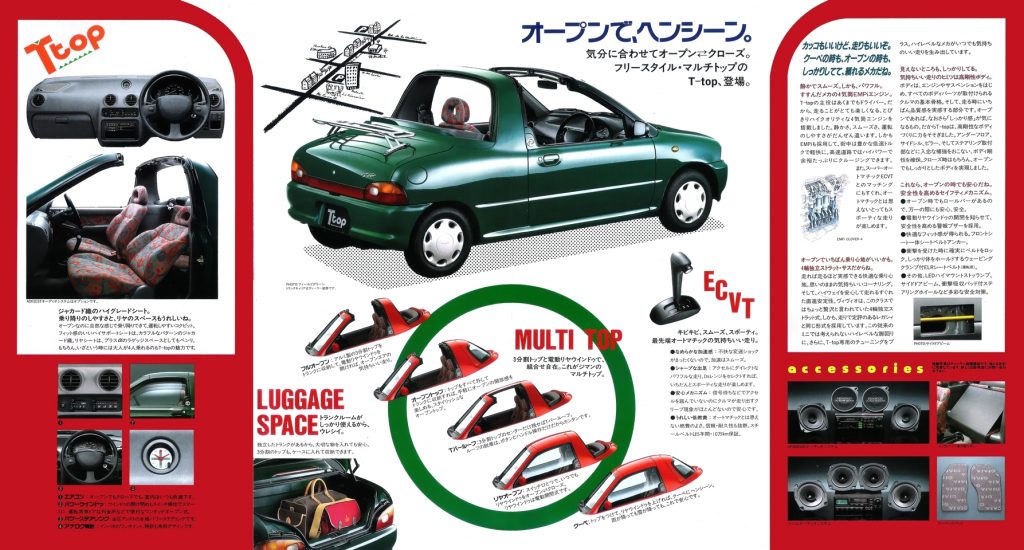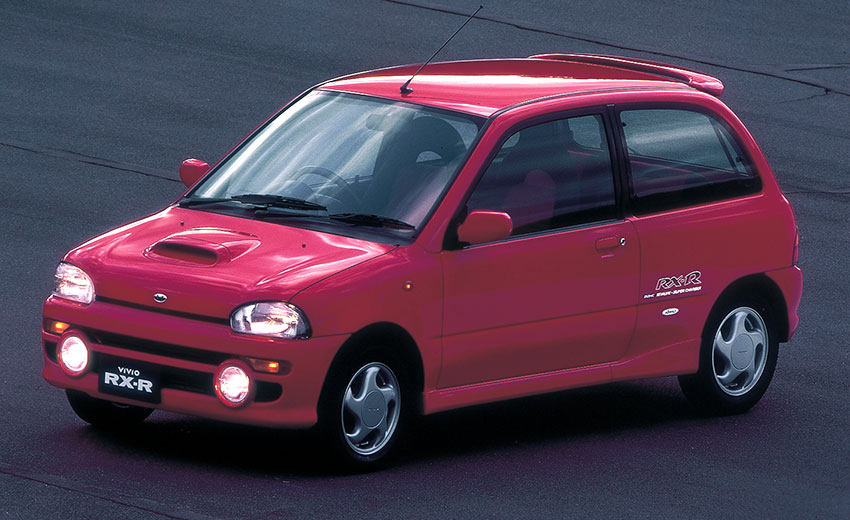
The minicar of Subaru called the Vivio was sold on many places around the world but the Japanese market had some unique versions. Introduced in 1992, the Vivio came to the Japanese market in more than 30 variations! 3-door, 5-door, manual transmission, CVT transmission, front wheel drive, four wheel drive; customers already had a lot of choice for the basic specifications. Then there were the grades:
| e | Entry grade with unpainted bumpers and no air-conditioning |
| ef | Low grade with painted bumpers and air-conditioning |
| el | Based on the ef with additional equipment such as an AM/FM radio with cassette player. Power steering could be had as an option. |
| em | Electric power windows and electric door mirror controls |
| em-p | Based on the em, this grade is focused at female buyers and got additional equipment such as UV-cut glass, a unique seat fabric and audio system. |
| ex a as | High grade version of the 3-door model. Compared to the em additional equipment included remote door lock, a driver airbag and pin stripe for the exterior. |
| es | High grade version of the 5-door model. In addition to the ex, the 5-door had tilt option for steering wheel, bronze glass and rear seat headrests. |
| GX | High grade with a more powerful engine and CVT transmission |
| RX-R | High grade with a more powerful engine and manual transmission |
The GX and RX-R grade had a supercharged version of the EN07 engine found in the other grades. This supercharged engine produced 64 horsepower and 88 Nm of Torque for the RX-R (because of DOHC) and 84 Nm for the GX (because of SOHC). The RX-R could only be had in the 3-door body while the GX could be had with both body styles.
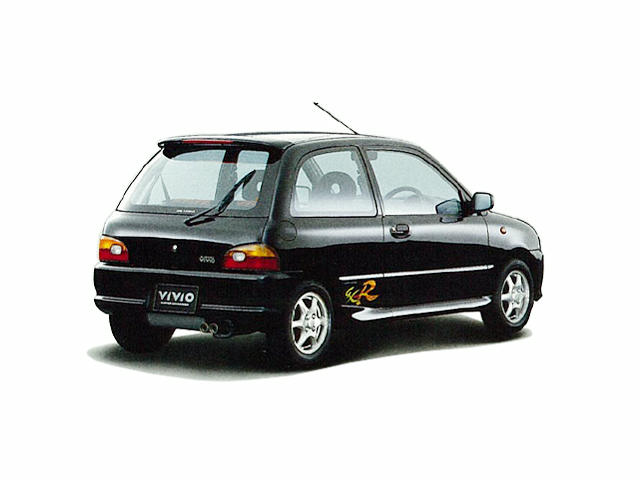
Other equipment of the RX-R included rear drum brakes, high grip tyres, sport seats and exterior aero parts. The GX also received some aero parts, a double muffler and the higher grip tyres. Both the RX-R and GX were available with the option of four wheel drive.
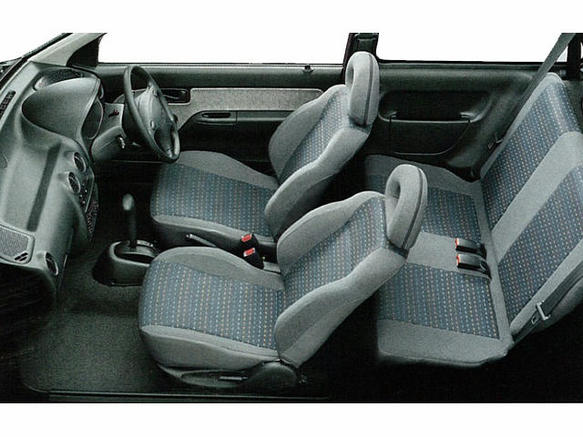
At the end of 1992 two new versions of the RX-R came available. The first one being the RX-R/S1, it was a limited version with high end audio, green glass and the option of a special silver color. The second new version was called RX-RA, a served as basis for motorsport. It was only available as four wheel drive, and got a lot of mechanical upgrades such as LSD for the rear, upgraded transmission and re-tuned suspension. Electric ancillaries such as air-conditioning and power steering were removed resulting in a 20 kilogram lighter weight. The car only weighted in at 750 kilogram.

In 1993 a new model based on the Vivio came to the market called the T-top. It was a celebration model to Subaru’s 40th anniversary. It was no longer a hatchback shape but looked more like a coupe. The roof could be removed and the rear window could be retracted to enjoy open driving. It came with the non-supercharged engine and both a manual transmission and CVT could be chosen. The model was limited to 3000 units and the conversion was done by the company Takada Kogyo, that also worked on the Nissan Silvia S15 Varietta and Nissan Figaro.
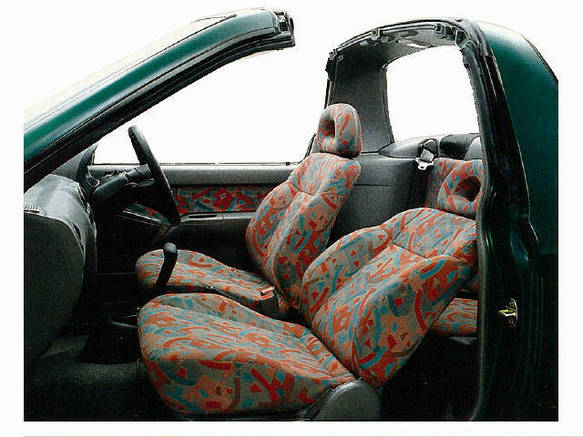
In February 1994 however, the T-top came with the supercharged engine as 1000 unit limited model. The grade was called GX-T and as the name suggests, it was similar to the GX grade and thus also used the CVT transmission.
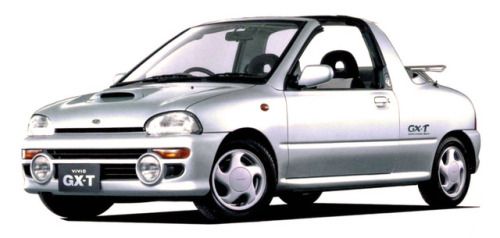
Around 1995 Subaru had sold 3 Million (300万 in Japanese) vehicles in the mini-car segment thanks to the good selling Vivio and its predecessors. That had to be celebrated and thus Subaru launched the M300 grade. It had a sporty appearance with luxury options such as a wood grain panel around the audio and an airbag for the driver but was equipped with the non-supercharged engine. Later on variations on this grade came called the M300 Type S and M300 supercharger with the Type S making it look even sportier as it sported the supercharged front (additional cooling openings) and had a rear spoiler. The M300 supercharger got the supercharged engine and BBS wheels as standard.

At the end of 1995 Subaru came with the Vivio Bistro, which had a different, more classical looking front. The interior had a little bit more upmarket feel compared to the regular Vivio. It came as 5-door only with the non-supercharged engine. There was the option for manual transmission or CVT as well as front wheel drive or four wheel drive. A year later a higher grade called the Bistro B-Custom was introduced, which had beige leather seats, leather steering wheel and a special color.
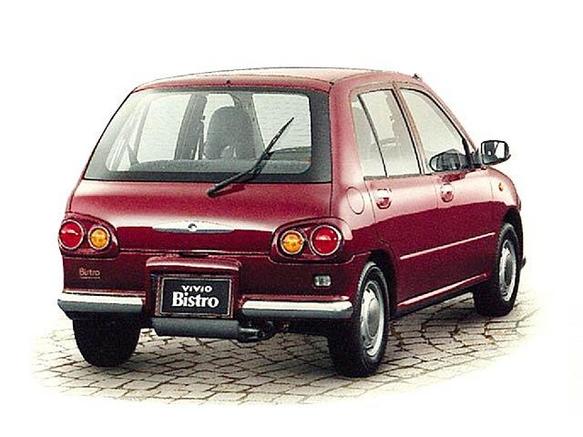
The Bistro Sport was introduced in January 1997 and was the more sporty version of the Bistro, using the supercharged engine with 64 horsepower and equipment similar to that of the GX grade. Two special colors (silver metallic and green mica) were available and the car always came on gold 13″ alloy wheels.
A bit later that year the RX grade also came available with a CVT transmission. This new grade was called the RX-SS. A similar grade became available for the Bistro, called the Bistro-SS. Both models could be had in front wheel drive only or four wheel drive.
By September 1998 the production of both Vivio models had stopped. In total 740.000 units have been sold. The successor to the Vivio is called the Subaru Pleo. An interesting fact is that the Vivio was also produced under license in China. The company Guizhou Youngman Yunque Automobile Company sold the Vivio in China as GHK 7070.
Click on the picture below to see all Vivio versions per year and detailed specifications such as weight, new price and equipment for each version in the Goo-net.com catalog.
Click on the picture below to see all Vivio Bistro versions per year and detailed specifications such as weight, new price and equipment for each version in the Goo-net.com catalog.
Bonus pictures:


